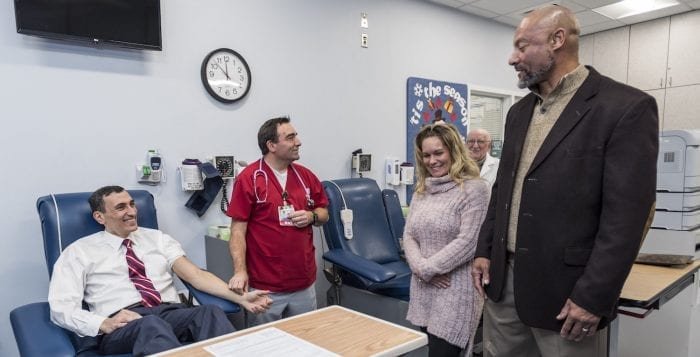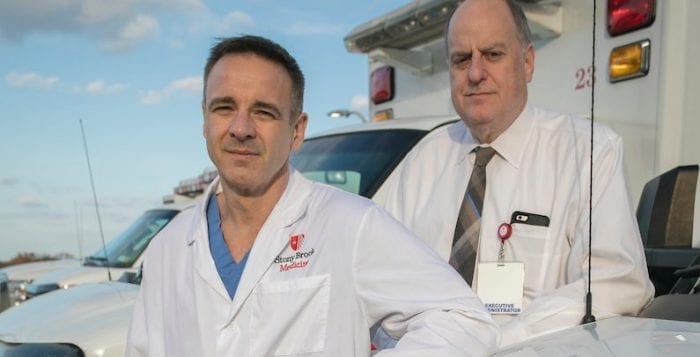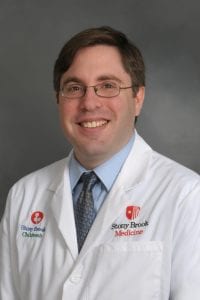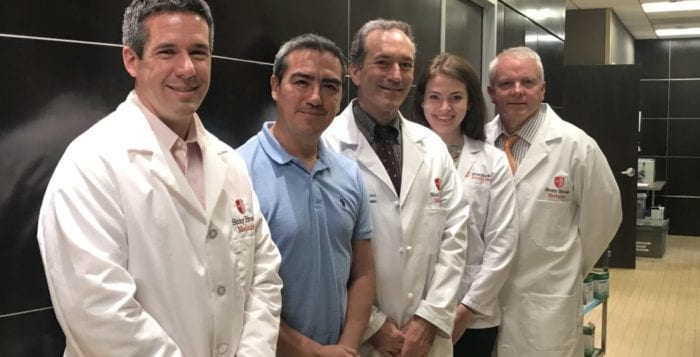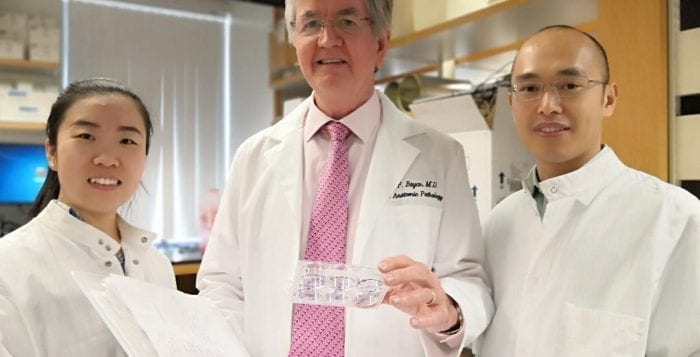Stony Brook University Hospital doctors and staff members joined a Marine veteran to get a head start on National Blood Donor Month, which runs through January.
“Today is a good reminder of how we can all join together in turning a catastrophic event into a remarkable get together with a lot of potential to save numerous lives.”
— Dr. Henry Tannous
At a Dec. 23 press conference at the hospital, Al Kirby, 52, announced a blood drive to show his gratitude to SBUH doctors and staff members. The Shirley resident’s life was saved Christmas Day 2018 at Stony Brook after 10 hours of surgery where 27 units of blood were needed. Kirby’s doctors, wife, children, friends and family members joined him for the announcement.
“Today is a good reminder of how we can all join together in turning a catastrophic event into a remarkable get together with a lot of potential to save numerous lives,” said Dr. Henry Tannous, co-director of the Stony Brook University Heart Institute and chief of the Division of Cardiothoracic Surgery.
According to SBUH officials, one blood donation can potentially save three lives.
“This crucial act of kindness will allow more families like the Kirbys to spend more holidays together,” Tannous said.
Kirby was loading up his car with gifts after a visit to his in-law’s house when he felt an intense stabbing pain in his chest, a rapid heartbeat and a burning sensation in his throat. His wife, Dawn Kirby, called 911 and asked the emergency responders to bring her husband to SBUH. His wife after the press conference said she credits the doctors and those who donated blood for saving her husband’s life and is grateful for his recovery.
“Every day is like Christmas,” she said.
Emergency department providers and the Heart Institute’s Cardiac Catheterization Lab’s team ruled out a coronary blockage and discovered Al Kirby had a severe aortic dissection. It took seven hours in the operating room for doctors to repair the rupture of his main aortic vessel. The procedure also prevented further dissection. The seven-hour operation was followed by another three hours to stop the internal bleeding.
“To me, the doctors are gods here and the staff are beyond angels, because of you I’m alive.”
— Al Kirby
Tannous said the medical team didn’t let their guard down and pushed on until they found a diagnosis. For the operation, he said medical staff members had to leave their families abruptly, and the cardiovascular operating room team worked tirelessly through the night.
“A 9 hour and 52 minutes surgery is surely a test of what’s humanly possible,” Tannous said.
The doctor said the blood bank was a “powerful ally” that had the operating room team’s backs. He added that if one link was missing in the system, the operation wouldn’t have been as successful as it was. Half of those who suffer from the same medical condition die within 24 hours.
Dr. Puja Parikh, interventional cardiologist and co-director of the Transcatheter Aortic Valve Replacement Program at SBU Heart Institute, said that since the surgery she has been working with Kirby on controlling his blood pressure and that he is doing well. Uncontrolled blood pressure and underlying aortic aneurysms are risk factors of the condition, even though it’s not known what caused the veteran’s medical emergency.
Kirby said the staff has increased the size of his family.
“To me, the doctors are gods here and the staff are beyond angels, because of you I’m alive, and I thank all of you for donating blood, which allowed someone like me … to be here speaking today,” Kirby said.
After the press conference, the veteran’s family and Stony Brook Medicine team members headed to the blood bank to donate where Tannous was the first to roll up his sleeves.
For more information on how to donate to the Stony Brook Blood Bank, call 631-444-3662 or visit www.stonybrookmedicine.edu/patientcare/bloodbank.

